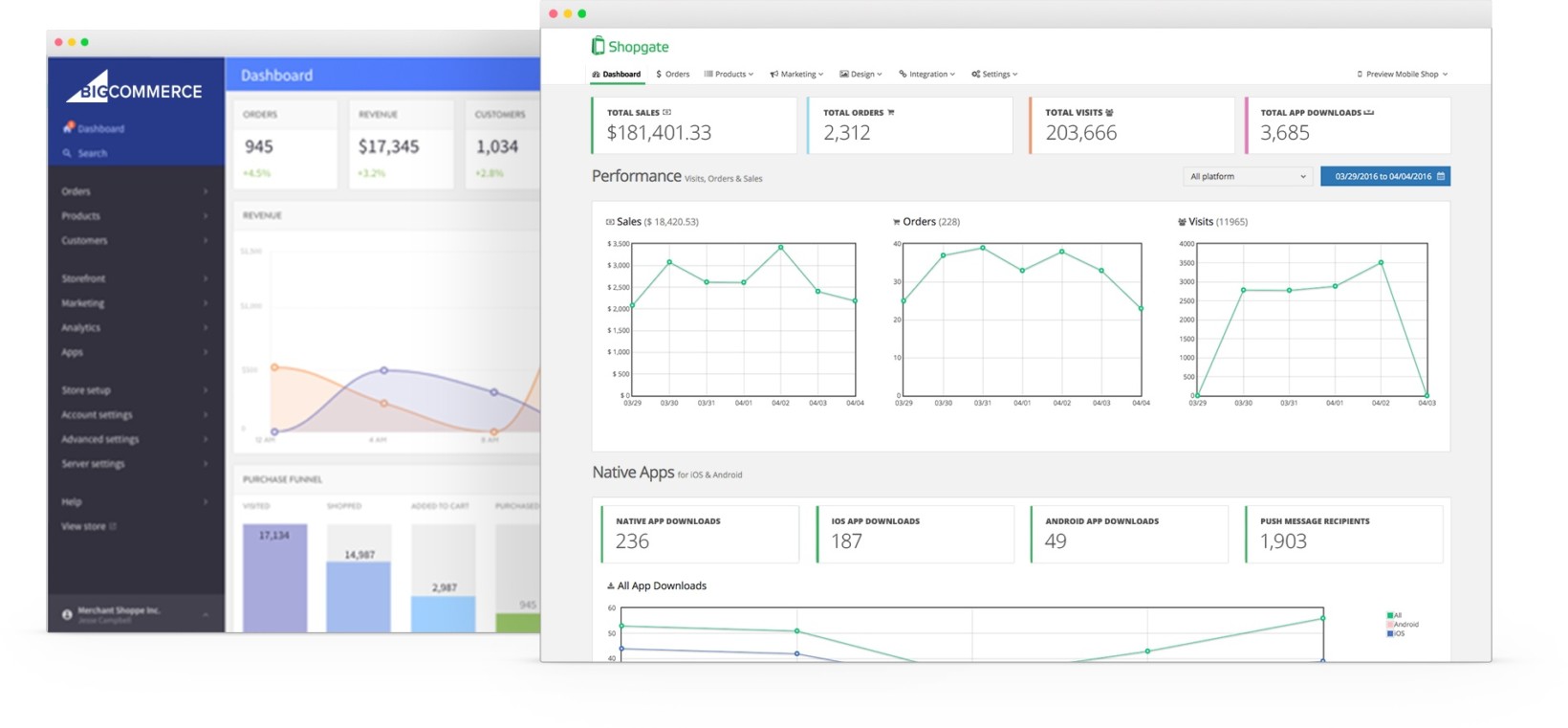
Our screens are getting smaller, our mobile devices are getting smarter while the e-commerce industry is getting bigger.
Bigger to the tune of $2.29 trillion by the end of the year, over one-third of which will come from purchases made on mobile devices in the US, according to eMarketer’s projections.
It’s not much of a shocker that m-commerce has been on the up-and-up for years now, is it? We’re spending more time with our smartphones, and using them for more types of activities than ever before. That said, the extent of which m-commerce is growing is rather striking.
Data from comScore shows that m-commerce growth eclipses other online retail spending, with over three times the growth of desktop e-commerce.

Image source: https://www.comscore.com/Insights/Presentations-and-Whitepapers/2016/The-State-of-the-U.S.-Mobile-Market
According to data by leading ecommerce platform BigCommerce, mobile orders from their platform’s 50,000 stores grew 30% year-over-year from 2015 to 2016. Five years ago, mobile sales were stagnant at 10%, whereas today, mobile purchases go account for nearly one-third of BigCommerce’s total.
This makes a lot of sense, especially given that BigCommerce has aggressively been rolling out mobile-friendly features in recent years, including single-page checkout, a diverse range of customizable, responsive website themes and integrations with mobile wallets like PayPal One Touch, Apple Pay and Amazon Pay.
Business Insider, moreover, estimates that mobile’s share of ecommerce revenues will continue to make gains in the years ahead, reaching 45% of the total US ecommerce market within the next three years.

Image source: http://www.businessinsider.com/mobile-commerce-shopping-trends-stats-2016-10
These numbers have huge implications when it comes to how the modern consumer shops and where e-commerce at large is headed. Becoming more and more dependent on our mobile devices means that e-commerce merchants, developers and marketers alike are scrambling to meet the needs of today’s buyers.
What are those needs, though? Let’s start by diving into five major trends that are changing the face of smartphone-powered shopping as we know it.
1.Smarter chatbots and mobile messengers
It’s rather tempting to scoff at the idea of m-commerce customer support chatbots, which may seem like little more than a novelty to skeptical merchants.
But the fact that massive names like Starbucks, H&M, and Nordstrom are on board should say a lot about just how much industry leaders are betting on chatbots.
Rest assured, this bet is based on data. According to eMarketer, the majority of today’s social media users prefer messenger apps (54.4%) to get in touch with brands versus email, phone calls or traditional online chat (46.6%). The end result is smart bots, which are essentially able to…
- reach customers and respond to requests from shoppers in real-time
- learn more about customers and essentially personalize the shopping experience based on their responses
- engage with customers without requiring that they install a native app since chatbots integrate with the likes of Facebook Messenger, Skype, Telegram, and Kik, for example
Obviously, bots still have a way to go. Even so, given the popularity of AI platforms such as Amazon’s Echo, modern shoppers have quickly become highly comfortable with the concept of tech that helps them shop.
2. The augmented reality revolution
Not totally unrelated to chatbots, the evolution of augmented reality apps related to e-commerce continues to boom despite the technology still being in its infant stages.
Yet we’re definitely seeing the possibilities through platforms such as the Houzz AR app, which allows shoppers to virtually position pieces of furniture in their homes to see if they’d be a good fit. Similarly, Sephora’s Virtual Artist app acts as a sort of virtual makeup mirror for users taking advantage of AR tech.

Image source: https://www.houzz.com/ideabooks/84553161/list/houzz-app-adds-3d-preview-to-help-you-shop
According to a recent report by Retail Perceptions, the push for AR is based on the wants and needs of consumers versus merchants looking to splash cash on fancy apps for themselves. The report notes that…
- 40% of shoppers would be willing to shell out more cash for a product if they could experience it via AR prior to purchase
- 61% of shoppers prefer brands taking advantage of AR versus those who aren’t
- 71% of people would feel more loyalty to a brand if they offered augmented reality as an option for shoppers
Much like chatbots, it’s easy to dismiss such apps as novelties as the technology is still evolving; however, given the insane popularity of AR apps like Pokemon Go, there’s certainly something to be said for the compelling, conversion optimizing, interactive nature of AR – which is, of course, exclusive to mobile.
3. The future of single-click payments
Although Amazon currently has somewhat of a monopoly on true one-click purchasing, thanks to a long-standing patent, leading mobile wallet players such as Google and Apple are scrambling to offer up their own one-click solutions for shoppers when that patent ends in September 2017.
The ability to drive repeat business in a single click minus re-entering information, or jumping through extra hoops, has been a cornerstone of Amazon’s success.
We’ll have to wait and see what these other names come up with to streamline the payment process for buyers, but it’s worthy to note that the increase of single-click payments could contribute to the phenomenon of impulse buying via mobile. By putting fewer barriers between shoppers and products, there are fewer opportunities to drop out of a transaction or have a change of heart. This spells good news for mobile ecommerce merchants in the near future.
4. Increased emphasis on automation
Marketing automation and ecommerce have always gone hand in hand, haven’t they? Thankfully, there are more opportunities than ever to put the essential aspects of marketing and selling on autopilot than ever before.
How so? Consider the wealth of automation tools specifically tailored for ecommerce today. Shopping cart abandonment re-engagement engines. Loyalty program generators. Platforms that aggregate product reviews. The list goes on.

Image source: http://flurrymobile.tumblr.com/post/157921590345/us-consumers-time-spent-on-mobile-crosses-5
Email marketing and social media in particular signal massive opportunities for ecommerce merchants. Considering we’re currently spending an average of five hours per day on our smartphones, and that email has become an increasingly mobile channel, merchants absolutely must be taking advantage of automation if they want to maximize their marketing spend.
5. The rise of storefront apps
It’s no secret that modern shoppers are glued to their mobile devices, leaving desktops in the dust. The bulk of that time is being spent within some sort of app, whether it be in the realm of social media, messaging or, you guessed it, shopping.
While there’s certainly room to debate the advantages and disadvantages of native ecommerce apps, there’s no denying the benefits to ecommerce brands when it comes to the ability to track, authenticate and reach their buyers via app notifications. Furthermore, boasting an app most definitely provides a more personalized experience for shoppers that’s out of the ordinary.
That said, additional data by BigCommerce notes that desktop purchases are on average 50% higher than that of mobile orders. As a result, it’s crucial for ecommerce storefronts to have their bases covered for mobile and desktop shoppers alike, with an omni-channel presence.
This is why platforms like Shopgate are so useful, as they help merchants to easily create integrated, branded mobile apps. This can help a great deal with customer retention, thanks to customizable push notifications, a well-designed interface and an overall great user experience.

Image source: https://www.shopgate.com/en/bigcommerce-mobile-app/
Even though storefront-specific apps are certainly changing the game, anything merchants can do to make the purchasing process easier on their customers is a major plus.
Conclusion
And honestly, that’s what it really comes down to, isn’t it? You know, making it easier on customers to make purchases and get from Point A to Point B when it comes to their shopping carts.
Easy payment options, less back-and-forth and more opportunities to interact with customers represent the top priorities mobile e-commerce merchants for now. It’s difficult to predict the upward trend of m-commerce spells great news for mobile merchants.
Get the TNW newsletter
Get the most important tech news in your inbox each week.





